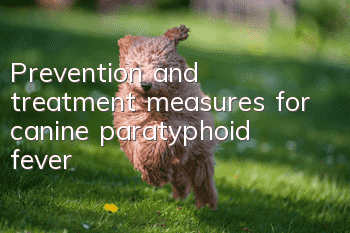Prevention and treatment measures for canine paratyphoid fever

Prevention and treatment measures for canine paratyphoid fever:
1. Strengthen feeding and management, improve the environment and kennel hygiene, clean and disinfect feeding and management equipment frequently, and pay attention to Do a good job in exterminating rats and flies, and dead dogs should be burned or buried deeply.
2. Breeders and veterinarians should pay attention to washing and disinfecting their hands after coming into contact with sick dogs.
3. Antibiotics can be used for treatment, including intramuscular injection of chloramphenicol, 2-4 times a day, for 4-6 days; intramuscular injection of kanamycin sulfate, dosage 13 mg/kg, twice a day.
4. Sulfa drugs also have good curative effects. Use sulfadiazine, dosage: 0.15 g/kg body weight for the first time, 0.075 g/kg body weight for maintenance, 2 times a day, for 1 week.
5. Native treatment: Take 10-30 grams of garlic, pound it into minced garlic and take it orally, 3 times a day for 3-5 days.
Symptoms of canine paratyphoid fever:
1. Enteritis type: The body temperature of sick dogs rises to 40-41°C, anorexia, abdominal pain, vomiting and diarrhea occur, and severe cases Dog feces contains blood, is watery, and becomes dry. The mucous membranes are pale, the body is weak, and shock and jaundice may occur before death. Some sick dogs will have neurological symptoms.
2. Septicemia type: The sick dog’s body temperature drops, the whole body collapses, and there is metastatic infection.
3. Pregnant female dogs may suffer miscarriage or stillbirth after being infected, and the puppies they give birth to will be born with stunted growth, weak constitution or become emaciated.
- How to take care of your dog when he goes home after surgery
- How to train a Samoyed for a walk?
- Things to note when training your dog
- What should Schnauzers eat to supplement calcium?
- Reasons why puppies sneeze and how to prevent them
- What happens if your dog is overnourished?
- How should first-time owners raise their newly arrived Silver Fox puppies?
- How to train VIPs to greet guests and shake hands proactively?
- What should I do if my Teddy dog’s anus is red and swollen?
- Can a human cold be transmitted to a dog?



